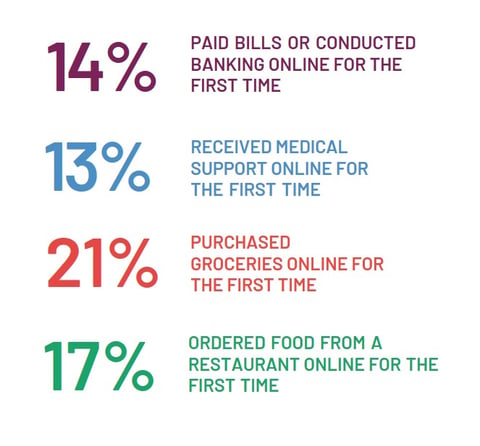Developing Managers Who Can Lead Digital Transformation
Download PDF of Article
The pandemic massively accelerated the move to a digital-first consumer market. Increased customer expectations and a need for genuine human interaction during customer experience moments of truth have elevated the role of the front line and their leaders. This article shares insights for managers on how to empower their team with the tools to overcome challenges presented in a remote environment and continue to deliver an excellent customer experience.
DIGITAL TRANSFORMATION TIMELINE
There was a time when digital “generations” were thought to have three-year cycles … enter COVID-19 and the end of conventional thinking. In under 30 days, customer service centers went from incredibly well-designed and well-managed offices to work-from-home networks held together by spare parts and the availability of exotic items like $2 patch cords that were suddenly in short supply. Even today, a year later, we still see the effects of this tsunami as we witness a global automotive production slowdown due to a shortage of computer chips. What happened to all of the chips? They’ve been diverted to all of those work-from-home computers. For more info, check out our post on The Rise, Fall & Resurgence of Vehicle Chips.
This shock to the system is felt even more significantly by the consumer. The pandemic instantly changed the average consumer’s expectation to a digital-first experience. With the ability to leave their homes suddenly gone, consumers turned to digital channels for everything: learning, entertainment, shopping and of course, work.1
The effects of this change were immediate, with 87% of customer service centers reporting an increase in digital channel use.2 In fact, Forrester reports the following “firsts” in adult consumer behavior during 2020:3
 These abrupt behavioral changes resulted in several service delivery changes, such as increased use of AI, chatbots and other digital self-help tools. While many consumers welcomed the shift, this increased availability of new technology prompted agents to become pandemic lifelines. Agents are now responsible for handling questions too complex for self-help tools, or helping novice digital customers learn how to use these newer, now mandatory, tools.
These abrupt behavioral changes resulted in several service delivery changes, such as increased use of AI, chatbots and other digital self-help tools. While many consumers welcomed the shift, this increased availability of new technology prompted agents to become pandemic lifelines. Agents are now responsible for handling questions too complex for self-help tools, or helping novice digital customers learn how to use these newer, now mandatory, tools.
The big insight from this evolution is a change in service delivery referred to as “digital transformation.” Rather than simply trying to digitize existing service delivery processes, forward-thinking companies are reimagining the world from a digital-first perspective and asking how customer service moments of truth are changing, i.e., transforming our understanding of customer expectations.
Insight #1: Customer expectations are always changing. Approaching systems, processes and communications from a digital-first perspective helps keep us in alignment with their needs.
LINKING TOOLS & AUTHORITY TO CUSTOMER SATISFACTION
At Morley, we have long believed that the single greatest driver of customer satisfaction is giving our front-line associates the tools and authority to do what they believe is right on behalf of the customer. It’s hard to imagine a moment more ripe for this theory to be put to the test. Digital transformation, reexamining customer expectations and adjusting service delivery to meet or exceed those expectations has been a real-time experiment for everyone in the customer service industry. According to Gartner, “When customer service reps feel the systems or tools they use enhance their ability to handle customer issues and simplify their day-to-day work, their productivity can increase by up to 20%, customer satisfaction increases by 11% and customer effort decreases by 9%.”4
The last element of this observation, customer effort, is worth examining further. Simply put, customer effort is the work that customers have to do to satisfy their own needs. The greater the effort, the lower the customer satisfaction. This directly relates to issues like first call resolution. If customers have to call back twice, they are less satisfied. This concept is often related to “anticipating customer needs,” and our current emphasis is anticipating needs that digital transformation has created. In this same study, Gartner claims that, “Customers are four times more likely to leave a customer service interaction more disloyal than when they arrived.” Let’s stop for a moment and read that again. Customers are 400% more likely to be less loyal following any customer service encounter. This statistic underscores the importance of viewing customer service delivery as critical to the customer journey.
On the plus side, customers who experience a low level of customer effort (the customer service rep meets or exceeds their expectations and anticipates their needs) are 94% more likely to repeat purchase (let’s hear it for tools and authority!). The insight is understanding how customers view customer effort in light of the digital transformation.
Insight #2: Digital transformation creates opportunities to exceed expectations by anticipating consumer needs and reducing customer effort.
LISTENING TO THE FRONT LINE
Implicit in serving the front-line customer service representatives is arming their leaders with the tools and authority they need to fully support their teams. This is never truer than during a paradigm shift. Taking into account the concepts of digital transformation and customer effort, we recently surveyed supervisors across our entire business process outsourcing organization. Based on what we have shared with you thus far, the survey results will not come as a surprise.
Biggest Challenges
If viewed from the standpoint of a team trying to cope with rapid digital transformation, this is almost a textbook response. An important note: These teams generally meet or exceed customer KPIs. In many cases they are the best-performing supplier group serving our customers. Yet, supporting technology issues, being able to communicate better with their teams and driving productivity are at the top of their list for biggest challenges. These are exactly the types of issues you would expect during a transformation, especially if your goal is to drive down customer effort.
Desired Training Topics
Again, exactly what you would expect to see as front-line leaders adopt a digital transformation mindset. The logical next steps are cycling these insights into training and preparing these leaders and their teams to properly deliver customer service against the changing customer needs reflected in the digital transformation. In addition to developing a custom curriculum on remote work topics for our managers, our front-line leaders have innovated solutions such as:
- Providing a dedicated IT liaison who can handle advisors’ individual technology issues so trainers can continue training instead of stopping the class to help.
- Using color-coding systems to ensure that customers’ call-in priority remains intact regardless of their method of communication.
- Leveraging digital collaboration tools to quickly poll advisors on IT issues that simultaneously impact large groups. Since walking the floor is no longer a means to gather details, this process provides an alternate method of obtaining real-time input.
We’ve implemented all of these new tactics in an effort to continue providing extraordinary experiences to our clients. At the same time, we recognize that contact center goals industrywide are evolving. In the pre-pandemic era, closing tickets and reducing handle times were often the main KPIs to measure contact center efficacy. Today, we see a shift toward fostering more valuable customer relationships and developing empathy for customers’ unique needs. In a separate Salesforce study, customer service qualities for the “new normal” are believed to be expertise, empathy and speed.5
Insight #3: Training & tools should incorporate the concept that empathy is rivaling expertise/product knowledge as a main KPI.
MOVING FORWARD
Our understanding of what it means to deliver exceptional customer service remains based on a theory that requires empowering front-line associates with the tools and authority to do what they think is right on behalf of the customer. What has changed is customers’ expectations following the digital transformation of the past 12 months. Our customers are more digitally savvy, they have higher expectations of our ability to personalize service delivery and they are less forgiving of errors. To overcome these challenges, we need to provide exceptional leadership at the front line so we can quickly train associates on the use of new digital tools and the application of evolving best practices. We need to respect the relationship between front-line associates and their immediate leader and work to empower those leaders with skills that breed confidence in their constituents.

 By
By



